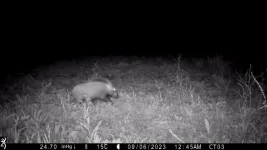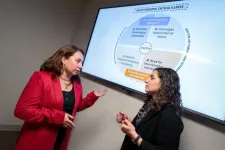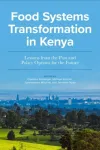(Press-News.org) In the ongoing biodiversity crisis, large terrestrial animals are more threatened by extinction than any other group of organisms. The African continent holds an impressively intact large-mammal community, but there is still a lot we do not know about how these species evolved, became diverse and adapted to the changing climate and habitats. Many of these questions can be addressed by investigating the genomes and genetic variation across species.
New research, published in Nature Communications, uses genomics to answer these evolutionary questions that have been debated amongst scientists for decades: 1) how and when did bushpigs cross the Mozambique Channel and arrive at the island of Madagascar, 2) is there one or two species of bushpigs?
Since their translocation from mainland Africa a couple of millennia ago, wild bushpig (Potamochoerus larvatus) roam freely in Madagascar (Northern humid forest, elevation ~1500m.) Credit: Jordi Saloma
- “This study is a result of a large international collaboration with researchers from Africa and Europe. We sequenced 67 complete bushpig genomes and by using a range of different genetic analyses, we were able to address these long-standing puzzles in African evolution and biogeography”, explains one of the senior authors of the study, Associate Professor at the Department of Biology, Rasmus Heller.
Were pigs ferried across the channel during the Medieval era?
The island of Madagascar separated from the African mainland around 160 million years ago, resulting in a largely unique flora and fauna. Remarkably, the bushpig is the only large, wild terrestrial mammal species that has somehow historically crossed the 400-kilometer-wide Mozambique Channel and made it from mainland Africa to the island of Madagascar.
- “Our study establishes that the bushpig was introduced to Madagascar ≈1,000-5,000 years ago from South/South-East Africa”, Rasmus states. Their arrival therefore coincides with the arrival of humans to Madagascar from a region around southern Africa. Rasmus continues: “The likely explanation for this is that people transported these bushpigs across the channel. These results contradict previously published studies which dated the arrival of bushpigs ≈480,000 years ago, well before humans were present on the island”. It has been suggested that some endemic Madagascar species might have arrived by rafting as passengers on floats of vegetation.
- “Intriguingly, our results raise a host of new questions: was the bushpig actually brought to Madagascar as a somewhat domesticated species? There is no archaeological or other evidence of bushpig domestication ever occurring, despite them being an important source of protein for many rural communities. And who was it that transported these animals to Madagascar? Was it Bantu-speakers, Austronesian-speakers or both? These questions and others still remain to be explored,” explains Renzo F. Balboa, postdoc at the Department of Biology and one of the leading authors of the study.
Does two actually equal one?
African bushpigs, which primarily are found in East/Southern Africa, and red river hogs, which are found in West/Central Africa, were considered the same species in the past, but were subsequently redefined as two species around the 1990s, largely due to their quite distinctive looks.
The red river hogs are, as the name implies red, and have long, tufted ears reminiscent of a comical Star Wars character, while eastern and southern African bushpigs are greyish and look more like our own wild boar, although with a beautiful white mane thrown in for good measure.
Biologists have been arguing for decades about whether these two forms are actually one or two different species - a debate that is characteristic of similar scientific uncertainty surrounding many other African mammals.
- “In this study, we were able to conclude that red river hogs and bushpigs have had lots of gene flow, which means they are not only able to potentially interbreed, but they have in fact done so extensively when they have met in central Africa. Furthermore, the branching of the two types in the Tree of Life is not all that old, only a few hundred thousand years, which is not long in the evolutionary scheme of things. Hence, we now know that although there are two quite different-looking lineages of bushpigs, their biological separation is incomplete, depending on how you define species”, explains Laura D. Bertola, postdoc at the Department of Biology and the other leading author of the study.
Laura continues: “Genomic data can give us insights into patterns of biodiversity on a much higher resolution than previously possible. For example, we can infer detailed population structure, but also underlying processes like gene flow and selection. Gaining improved insights into patterns of biodiversity and the underlying processes that drive them, will be crucial for effective conservation measures”.
Africa is a unique continent regarding the diversity of the megafauna which is still around. Studying the evolutionary history of these species can give us important insights into African biodiversity, which is highly relevant at a time where biodiversity is being lost at an alarming pace. The new findings contribute to our understanding of prehistoric relations between Africa’s humans and wildlife, but also the very fundamentals about how much biodiversity there is on this amazing continent.
- “This study is a great example of how involving local researchers and wildlife management authorities can lead to more robust and inclusive scientific research”, co-author Vincent Muwanika, Associate Professor of Conservation Biology, at Makerere University, Uganda, concludes.
The study is part of the African Wildlife Genomics research framework led by research groups at the Department of Biology at the University of Copenhagen. This research framework is an associated partner project of the African BioGenome Project (https://africanbiogenome.org/) - an African-led initiative to use genomics in the service of conservation and capacity building in Africa.
Find the article here Nature Communications
The study was supported by the Independent Research Fund Denmark, the Carlsberg Foundation, Villum Foundation and other funding sources.
END
How did the bushpig cross the strait? A great puzzle in African mammal biogeography solved by genomics
2024-01-08
ELSE PRESS RELEASES FROM THIS DATE:
Acute pediatric critical illness definition enables global research
2024-01-08
(MEMPHIS, Tenn. – January 05, 2023) St. Jude Children’s Research Hospital investigators collaborated with a global group of acute pediatric critical illness experts to reach a consensus definition of the condition. Research on how to improve care in low- and middle-income countries has been stymied because conventional pediatric critical illness definitions are not applicable in these settings. The new, more universal definition, reached by consensus among researchers and clinicians from 40 countries, will enable scientists to study pediatric critical illness more universally, which should lead to improvements in patient outcomes ...
A new book provides a roadmap for food systems transformation in Kenya
2024-01-08
The past few years have seen Kenya, along with many other countries, confronted with multifaceted and compounding challenges. The disruptions caused by COVID-19, high levels of food price inflation, and environmental crises, such as locust infestations and droughts, have severely tested the resilience of Kenya’s food systems and the affordability of food for its citizens. Against this backdrop of challenges and ongoing demographic shifts, urbanization, and stagnating agricultural production, ...
High-quality nursing home dementia care is not only a matter of adding staff
2024-01-08
Irvine, Calif., Jan. 8, 2024 — Additional staffing alone will not be sufficient to bridge the quality-of-care and health outcome disparities among nursing home facilities with varying percentages of residents with dementia, according to a first-of-its-kind study led by the University of California, Irvine. Specialized training, an easy-to-navigate environment and staff stability are also critical to meeting the unique challenges presented by this population.
The findings, recently published online in the journal Health Services Research, indicate that increased staffing generally improves outcomes for all patients but that at any given level of staffing, discrepancies ...
Use of habitat for agricultural purposes puts primate infants at risk
2024-01-08
Frequent visits to oil palm plantations are leading to a sharp increase in mortality rates among infant southern pig-tailed macaques (Macaca nemestrina) in the wild, according to a new study published in Current Biology. In addition to increased risk from predators and human encounters, exposure to harmful agricultural chemicals in this environment may negatively affect infant development.
In wild populations, infant survival is crucial for determining individual fitness and for maintaining viable populations in changing environments. For primates, ...
Clinical research shows AI-enabled digital stethoscope can detect pregnancy-related heart disease
2024-01-08
JACKSONVILLE, Florida — New research from Mayo Clinic suggests that artificial intelligence (AI) could improve the diagnosis of peripartum cardiomyopathy, a potentially life-threatening and treatable condition that weakens the heart muscle of women during pregnancy or in the months after giving birth. Researchers used an AI-enabled digital stethoscope that captures electrocardiogram (ECG) data and heart sounds to identify twice as many cases of peripartum cardiomyopathy ...
Franco-German research funding in the field of biology
2024-01-08
The joint funding program of the French National Research Agency (ANR) and the German Research Foundation (DFG) promotes Franco-German cooperation in the natural sciences, the life sciences, and the engineering sciences. Through this program, Johannes Gutenberg University Mainz (JGU) will receive support for two distinctive projects in the field of biology.
The EVOMET project: Uncovering the evolution of metabolism in plants
Tomatoes, cucumbers, and potatoes taste different due to the accumulation ...
Fastest swimming insect could inspire uncrewed boat designs
2024-01-08
ITHACA, N.Y. – Whirligig beetles, the world’s fastest-swimming insect, achieve surprising speeds by employing a strategy shared by speedy marine mammals and waterfowl, according to a new Cornell University study that rewrites previous explanations of the physics involved.
The centimeter-long beetles can reach a peak acceleration of 100 meters per second and a top velocity of 100 body lengths per second (or one meter per second).
Not only do the results explain the whirligig’s Olympian speeds, but they also offer valuable insights for bio-inspired designers of near-surface water robots and uncrewed boats.
Until ...
Why do we sleep? Researchers propose an answer to this age-old question
2024-01-08
Sleep is a fundamental need, just like food or water. “You’ll die without it,” said Keith Hengen, an assistant professor of biology at Washington University in St. Louis. But what does sleep actually accomplish? For years, the best researchers could say is that sleep reduces sleepiness — hardly a satisfying explanation for a basic requirement of life.
But by melding concepts from the fields of physics and biology, Hengen and a team of Arts & Sciences researchers have constructed a theory that could explain both the meaning of sleep and the complexity of the brain. As reported in a new study published ...
Singh studying distributed computing models and algorithms for pervasive systems
2024-01-08
Gurdip Singh, Divisional Dean, School of Computing, received funding from the National Science Foundation for the project: "EAGER: Distributed Computing Models and Algorithms for Pervasive Systems."
The goal of this project is to extend the traditional graph-based distributed computing models and algorithms to develop a unified model to study cyber-physical systems. The unified models will capture interactions between the physical and cyber entities and the physical phenomena. This project also proposes to develop techniques to design distributed algorithms for fundamental problems ...
Narayanan developing treatments for alphaviruses
2024-01-08
Aarthi Narayanan, Professor, Biology, received funding for the project: "Further the development of Omaveloxolone and Bardoxolone methyl as broadly effective countermeasures against alphaviruses to Support the Battelle Accelerated Therapeutics for Combating Acute Viral Epidemics (BAT-CAVE) Program."
The principal purpose of this program is to conduct Research and Development into medical, pharmaceutical, and diagnostic technologies to enhance mission effectiveness of military personnel, collaborating ...




